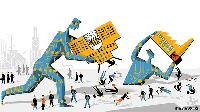
World is witnessing the rise of digital technologies that constantly changes industry, business and living environment at present. We are witnessing what many economic historians describe the fourth industrial revolution that uses exponential technologies — robotics, artificial intelligence (AI), sensors, 3D printing, nanotechnology, quantum computing which are changing the manufacturing sector.
Following are the features of the first three industrial revolutions.
- The First Industrial Revolution used water and steam power to mechanize production.
- The Second used electric power to create mass production.
- The Third used electronics and information technology to automate production.
Fourth industrial revolution is driven by exponential technologies like the above mentioned ones and the internet. Several new technologies are changing the industrial, economic activities as well as influencing the way of living of the people.
For example, the development of artificial intelligence or machine learning produced several intelligent machines that think, speak and perform activities. Self-driving cars and drones to virtual assistants and software that searches, analyses and teaches are going to change the world soon.
Under the new industrial revolution where technological changes are disruptive, innovation rather than mass production is the driver of the manufacturing sector.
The World Economic Forum 2016 has made Fourth Industrial Revolution as the theme of the summit in June.
According to the Forum, “Fourth Industrial Revolution, finally, will change not only what we do but also who we are.”
Several countries have already made national policies to make use of the fourth industrial revolution wave. Germany launched industry 4.0 that integrates new developments including internet, virtual labs, cyber physical systems etc., into the manufacturing sector. Integrating manufacturing with the internet is one of the critical policies that the plan proposes.
Responding to the West’s industry 4.0, China has launched an impactful ‘Made in China 2025 Plan’ to upgrade its manufacturing competence to that of the industrialized countries. According to the Chinese government, the new plan is a guide to make the country a manufacturing super power.
At the same time, there are several experts who believe that the fourth industrial revolution that gives priority to priority to hyper innovation and machine learning produce some adverse effects.
Economists Erik Brynjolfsson and Andrew Mcafee have point out that the revolution could yield greater inequality, particularly in its potential to disrupt labor markets. The World Bank in its recent report added that automation posing threat to 69% of Indian jobs.
*********









